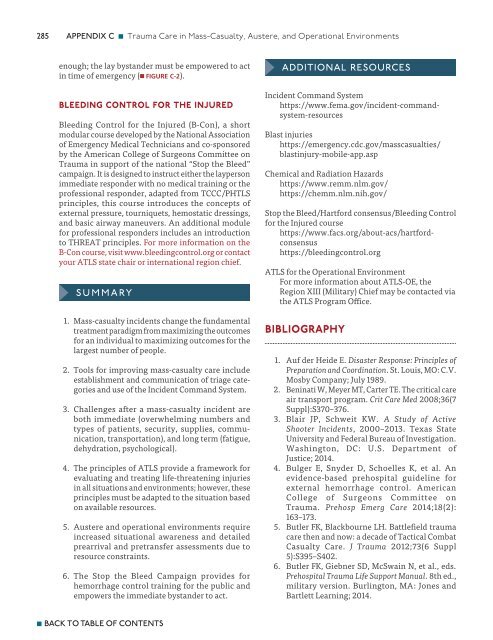Advanced Trauma Life Support ATLS Student Course Manual 2018
Create successful ePaper yourself
Turn your PDF publications into a flip-book with our unique Google optimized e-Paper software.
285<br />
APPENDIX C n <strong>Trauma</strong> Care in Mass-Casualty, Austere, and Operational Environments<br />
enough; the lay bystander must be empowered to act<br />
in time of emergency (n FIGURE C-2).<br />
Bleeding Control for the Injured<br />
Bleeding Control for the Injured (B-Con), a short<br />
modular course developed by the National Association<br />
of Emergency Medical Technicians and co-sponsored<br />
by the American College of Surgeons Committee on<br />
<strong>Trauma</strong> in support of the national “Stop the Bleed”<br />
campaign. It is designed to instruct either the layperson<br />
immediate responder with no medical training or the<br />
professional responder, adapted from TCCC/PHTLS<br />
principles, this course introduces the concepts of<br />
external pressure, tourniquets, hemostatic dressings,<br />
and basic airway maneuvers. An additional module<br />
for professional responders includes an introduction<br />
to THREAT principles. For more information on the<br />
B-Con course, visit www.bleedingcontrol.org or contact<br />
your <strong>ATLS</strong> state chair or international region chief.<br />
SummARy<br />
1. Mass-casualty incidents change the fundamental<br />
treatment paradigm from maximizing the outcomes<br />
for an individual to maximizing outcomes for the<br />
largest number of people.<br />
2. Tools for improving mass-casualty care include<br />
establishment and communication of triage categories<br />
and use of the Incident Command System.<br />
3. Challenges after a mass-casualty incident are<br />
both immediate (overwhelming numbers and<br />
types of patients, security, supplies, communication,<br />
transportation), and long term (fatigue,<br />
dehydration, psychological).<br />
4. The principles of <strong>ATLS</strong> provide a framework for<br />
evaluating and treating life-threatening injuries<br />
in all situations and environments; however, these<br />
principles must be adapted to the situation based<br />
on available resources.<br />
5. Austere and operational environments require<br />
increased situational awareness and detailed<br />
prearrival and pretransfer assessments due to<br />
resource constraints.<br />
6. The Stop the Bleed Campaign provides for<br />
hemorrhage control training for the public and<br />
empowers the immediate bystander to act.<br />
Additional Resources<br />
Incident Command System<br />
https://www.fema.gov/incident-commandsystem-resources<br />
Blast injuries<br />
https://emergency.cdc.gov/masscasualties/<br />
blastinjury-mobile-app.asp<br />
Chemical and Radiation Hazards<br />
https://www.remm.nlm.gov/<br />
https://chemm.nlm.nih.gov/<br />
Stop the Bleed/Hartford consensus/Bleeding Control<br />
for the Injured course<br />
https://www.facs.org/about-acs/hartfordconsensus<br />
https://bleedingcontrol.org<br />
<strong>ATLS</strong> for the Operational Environment<br />
For more information about <strong>ATLS</strong>-OE, the<br />
Region XIII (Military) Chief may be contacted via<br />
the <strong>ATLS</strong> Program Office.<br />
Bibliography<br />
1. Auf der Heide E. Disaster Response: Principles of<br />
Preparation and Coordination. St. Louis, MO: C.V.<br />
Mosby Company; July 1989.<br />
2. Beninati W, Meyer MT, Carter TE. The critical care<br />
air transport program. Crit Care Med 2008;36(7<br />
Suppl):S370–376.<br />
3. Blair JP, Schweit KW. A Study of Active<br />
Shooter Incidents, 2000–2013. Texas State<br />
University and Federal Bureau of Investigation.<br />
Washington, DC: U.S. Department of<br />
Justice; 2014.<br />
4. Bulger E, Snyder D, Schoelles K, et al. An<br />
evidence-based prehospital guideline for<br />
external hemorrhage control. American<br />
College of Surgeons Committee on<br />
<strong>Trauma</strong>. Prehosp Emerg Care 2014;18(2):<br />
163–173.<br />
5. Butler FK, Blackbourne LH. Battlefield trauma<br />
care then and now: a decade of Tactical Combat<br />
Casualty Care. J <strong>Trauma</strong> 2012;73(6 Suppl<br />
5):S395–S402.<br />
6. Butler FK, Giebner SD, McSwain N, et al., eds.<br />
Prehospital <strong>Trauma</strong> <strong>Life</strong> <strong>Support</strong> <strong>Manual</strong>. 8th ed.,<br />
military version. Burlington, MA: Jones and<br />
Bartlett Learning; 2014.<br />
n BACK TO TABLE OF CONTENTS

















